Going retro: Tokyo Station, and 17 historical train stations in Japan!
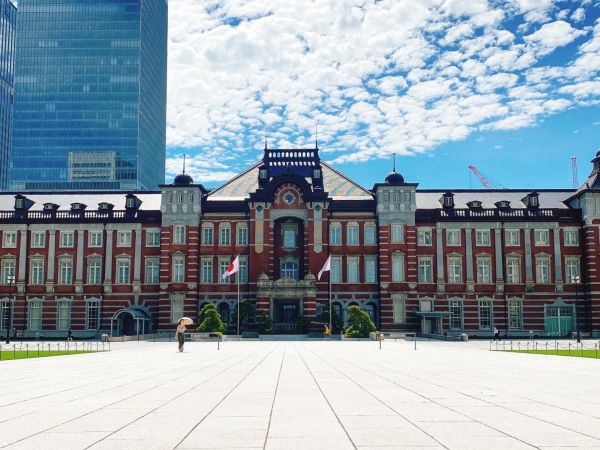
Railways have been part of Japanese society for more than a century. As the railway network expanded, railway stations were built, making it convenient for people to gather from all over the country. The overall traffic became a lot more active, and with it came economic wealth and prosperity.
In fact, a handful of railway stations in Japan are designated as Cultural Properties (文化財 bunka-zai), a title administered specially by the Japanese government’s Agency of Cultural Affairs for properties to be preserved as symbols of heritage of the Japanese people. They can be tangible, such as artworks and handicrafts, or intangible, like performing arts and craft techniques. They can also include cultural landscapes and monuments that are historic, cultural, and natural. And of course, they can include buildings such as railways stations.

Map of selected retro stations in Japan. (Image credit: Google Maps)
A railway station is the gateway to the city, and thus in Japan it can be said that the station is the "face" of the city itself. And among the numerous railway stations, a handful have a long history with invaluable cultural worth. In this article, I want to introduce to you stations with cultural property values representative to Japan. In fact, go out and visit these stations the next time you travel to Japan. Let's have a look!
Tokyo Station (東京駅)
Important Cultural Property (重要文化財)

Tokyo Station, day and night. (Image credit: JR-EAST HOTELS)
After railway travel was introduced in Japan in 1872, railway tracks and railway stations were being rapidly built across the country. In 1889, there were discussions on connecting the Tokaido Main Line (東海道本線 Tōkaidō-honsen)—its terminal station being Shimbashi Station (新橋駅 Shinbashi-eki)—with the Nippon Railway terminal at Ueno (now Tōhoku Main Line (東北本線 Tōhoku-honsen)) via an elevated railway line. This resulted in the Tokyo Station, whose construction began in 1908.
The station opened six years later, on 20 December 1914, and back then it only had four platforms and gates were only on the Marunouchi (丸の内)/eastern side facing the Tokyo Imperial Palace. The Yaesu (八重洲)/eastern side of the station was completed only 15 years later, in 1929.
Tokyo Station’s iconic red brick building. (Image credit: JR East)
The station’s original red brick building sustained heavy damage during World War 2, and though it was quickly rebuilt, it was only partially restored. Originally, the building had three levels and north and south domes, but after the war, the third floor was removed, and the domes were demolished.

Tokyo Station before restoration (top), and after restoration (below). (Image credit: The Railway Museum / JR East)
After the privatisation of Japan National Railways (JNR) into Japan Railways Group (JR Group) in 1987, there were calls to fully restore Tokyo Station’s red brick building. This eventually led to its designation as an Important Cultural Property (重要文化財 Jūyō-bunkazai) in 2003. Then, in 2007, it was momentously announced that the station will undergo a 5-year restoration and preservation process.

Tokyo Station’s original red brick building upon completion in 1914. (Image credit: The Railway Museum)

Tokyo Station’s dome interiors upon completion in 1914. (Image credit: JR East)
The process formally began on 30 May that year, and the main objective was to fully restore the station’s red brick building to its former original self while adding new amenities and facilities. That included rebuilding the third floor, restoring the north and south domes (also note how different the dome shapes are before and after restoration; previously it was polygonal but after restoration it's hemispherical), building a new parking lot, developing new seismic isolation structures to withstand earthquake tremors, and more.
Tokyo Station’s dome interiors in present day. (Image credit: JR Times / Sue Lynn)
After 5 years, and with an estimated budget of ¥50 billion, the restoration for the Tokyo Station was finally completed in 2012. The station’s iconic red brick building exteriors have been restored to their original glory, and now it also houses Tokyo Station Hotel, JR East’s luxury flagship hotel.
The Tokyo Station Hotel boasts unparalleled luxury and hospitality, and unlike most other luxury hotels, it is directly connected to Tokyo Station, making rail travel to other places a breeze! The hotel opened in 1915, just one year after the opening of the railway station, and it celebrated its 100th anniversary in 2015.
To this day it remains to be one of the best hotels in Japan and around the world, winning many prestigious awards and accolades over the years, and with many famous writers and prominent figures having stayed here before.
My colleague Sue Lynn also had the privilege to stay at the hotel, and wrote about her experience in more detail. Check it out here!

Tokyo Station Hotel's entrance and reception. (Image credit: JR-EAST HOTELS)
There are a few Important Cultural Property-designated railway stations in Japan other than Tokyo Station. The next one is located in the far west of the country, now not serving as a railway station anymore but nevertheless is a historical relic from the past.
Former Taisha Station (旧大社駅)
Important Cultural Property (重要文化財)

Former Taisha Station. (Image credit: photoAC)
In the town of Taisha (大社町 Taisha-machi) in Shimane Prefecture (島根県 Shimane-ken) sits an opulent piece of architecture that stands out from the quiet surroundings: Taisha Station. This grand building used to be a railway station on the Taisha Line (大社線 Taisha-sen), a line formerly operated by JR West that opened in 1912, but was permanently discontinued in 1990, leading to the closure of the station.
The wooden building was made to resemble Izumo Taisha (出雲大社), one of the oldest and most important Shintō shrines in Japan also located in Shimane Prefecture. It was preserved after train services were discontinued, and designated as an Important Cultural Property in 2004.
The building is a 15–20-minute walk from Izumotaisha-mae Station (出雲大社前駅 Izumotaisha-mae-eki), which is the present-day railway station for the area. It is an outstanding example of pure Japanese architecture, and visitors will feel like they’ve been transported back in time upon setting foot in it!
Next, we go further southward in Japan where another imposing railway station can be found, and this one exhibits a completely different architecture style.
Mojikō Station (門司港駅)
Important Cultural Property (重要文化財)
Mojikō Station. (Image credit: JR Kyushu)
Mojikō Station is located in the city of Kitakyushu (北九州市) in Fukuoka Prefecture (福岡県) in the region of Kyushu (九州). The region is famous for having amazing, larger-than-life Western architectures as remnants of its Western historical influences, and this railway station is a prime example.
The station is operated by JR Kyushu along the Kagoshima Main Line (鹿児島本線 Kagoshima-honsen). It opened in 1891 and served as a gateway station for passengers transiting between Honshu (本州) and Kyushu. Back then, passengers travelled between the main islands by ship crossing the Kanmon Straits (関門海峡 Kanmon-kaikyō) before the development of Kanmon Tunnel. The current station building was completed later in 1914, after the station was moved to its current-day location, and in 1988 it was designated as an Important Cultural Property.
Mojikō Station’s interiors. (Image credit: JR Kyushu)
The vintage building is designed according to Neo-Renaissance architecture, and served as the railway station building for almost a century. In 2012, it was announced that it would undergo a major renovation that spanned 7 years, and the newly refurbished building was completed in 2019.
There are also other notable railway stations throughout with historical and retro buildings with Cultural Property designations. Have a look below for more details.
(Note: the railway stations below are arranged according to JR region, from north to south.)
① JR Hokkaido (JR北海道) area
Otaru Station (小樽駅)
Registered Tangible Cultural Property (登録有形文化財)
Otaru Station in Hokkaido. (Image credit: Hokkaido Railway Company)
Otaru is one of the most popular tourist destinations in Hokkaido and visitors almost always make their way here via Otaru Station. This station first opened as far back as 1903, and the building standing today was first completed in 1934.
Greeting bell, formerly used at the station. (Image credit: Hokkaido Railway Company)
The building was considered a rare kind of railway station from the early Showa Period (昭和時代 Shōwa-jidai, 1926–1989), since it was built with steel-framed reinforced concrete, and furthermore, the windows are made with Kitaichi glass, a specialty of Otaru. The station was designated as a Registered Tangible Cultural Property (登録有形文化財 tōroku-yūkei-bunkazai) in 2006.
Former Muroran Station (旧室蘭駅)
Registered Tangible Cultural Property (登録有形文化財)
Former Muroran Station in Hokkaido. (Image credit: Hokkaido Railway Company)
Muroran Station in Hokkaido is one of the oldest in Japan, first opening as early as 1912, and the building (above) served as the railway station for more than a hundred years. In 1997, Muroran Station was moved into the currently-used fourth-generation building, located 600m southwards. The former station building was designated as a Registered Tangible Cultural Property in 1999, and has since been converted into the Muroran Sightseeing Information Center.
② JR East (JR東日本) area
Harajuku Station (原宿駅)
The old Harajuku Station building. (Image credit: JR East)
Mention Harajuku (原宿), and many people would immediately imagine the district famous for street fashion and the bustling main street of Takeshita (竹下通り Takeshita-dōri). To get to this bustling street, people would make a stop at Harajuku Station (原宿駅 Harajuku-eki), the only JR station specially serving this district.
Visitors who have passed by Harajuku Station would remember its distinctive wooden station building, which was built in 1924. It was a two-level building with a spire roof, and it exhibited English half-timbered style architecture. It was an iconic façade of the district, and this building served as the railway station for almost 100 years.
In 2016, it was announced that Harajuku Station would undergo a major renovation in light of the upcoming Olympic Games in Tokyo four years later. It would involve dismantling the wooden building to address overcrowding issues and fire prevention standards. Harajuku Station’s new railway station building was opened on 21 March 2020, just in time for the Olympics Games which was originally scheduled for August, and it featured new facilities such as restrooms, escalators and ticket gates.
On 7 August this year, JR East announced that it would rebuild a replica of the old station adjacent to the current one, reusing the materials dismantled from it and ensuring it would look as much like the old station building as possible. Today, visitors can see and contrast the old and new designs of the station.
Trivia: there is a private platform built in 1925 specially for use by the Emperor of Japan just north of the station’s main platform. The private platform hasn’t been used for a very long time, but it still stands to this day.
Nikkō Station (日光駅)
Nikkō Station. (Image credit: JR East)
Nikkō is a one of the cultural and historical epicentres in Honshū, and visitors will usually make their way to this city by train via Nikkō Station. It first opened as early as 1890 as a private railway station, and later became a national railway station in 1909. The second-generation building (image above) was completed in 1912, designed according to Neo-Renaissance architecture with half-timbered wooden Western styles, and it also underwent renovations twice: first in 2009 as part of 120th anniversary, and second from May 2016 to March 2017.
③ JR Central (JR東海) area
Kamezaki Station (亀崎駅)
Kamezaki Station. (Image credit: JR Central)
In the city of Handa (半田市) in Aichi Prefecture (愛知県) is Kamezaki Station. This is said to be the oldest railway station in Japan that still operates today since its opening in 1886. There was a fire that broke out in 1895, and it wasn't certain whether it completely burnt the station building.
The station used to be for transporting passengers and freight, but use for the latter was discontinued in 1975. An overhead pass was built at the station in 2014, thereby giving an interesting contrast between the station’s vintage building with the modern bridge.
④ JR West (JR西日本) area
Former Nagahama Station (旧長浜駅)
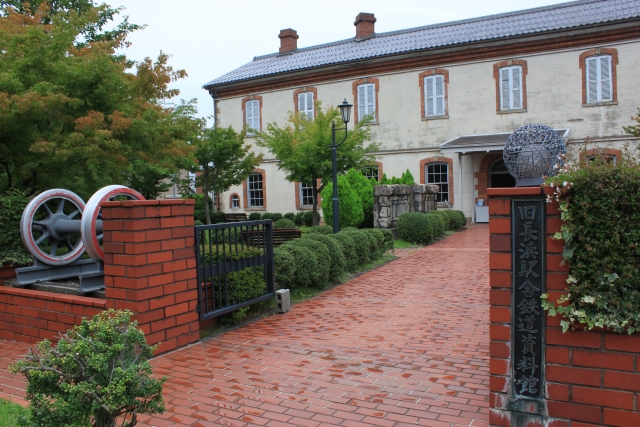
Former Nagahama Station entrance. (Image credit: photoAC)
If you want to see the oldest preserved railway station in Japan however, head on over to the western side of Japan, specifically to the city of Nagahama (長浜市) in Shiga Prefecture (滋賀県). In this city lies the former Nagahama Station, built in 1882 and thus having the title of being the oldest railway station building in the country.
The railway station was built as a terminal between Nagahama and Tsuruga (敦賀) in Fukui Prefecture (福井県). When the railway station’s second-generation building was built in 1903, this building was then used as a warehouse. In 1953, it was then designated as a railway memorial hall, and finally in 2000, it was re-opened as the Nagahama Railroad Square (長浜鉄道スクエア Nagahama-tetsudō-sukuea), where visitors can witness the building’s original architecture and enjoy exhibits such as steam locomotives and the longest model railway in Japan at 66m.
Hagi Station (萩駅)
Registered Tangible Cultural Property (登録有形文化財)

Hagi Station. (Image credit: photoAC)
Hagi Station is located in Hagi city in Yamaguchi Prefecture (山口県). This quaint, light blue-coloured station was built in 1925, and the western half of the station is an exhibition and museum hall that showcase Hagi’s history and nature. The building was designated as a Registered Tangible Cultural Property in 1996.
Nishiiwakuni Station (西岩国駅)
Registered Tangible Cultural Property (登録有形文化財)
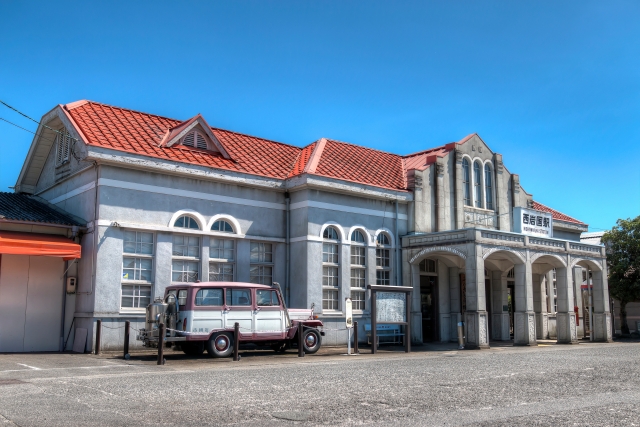
Nishiiwakuni Station. (Image credit: photoAC)
There’s another railway station in Yamaguchi Prefecture with a very retro railway station building steeped with historical significance: Nishiiwakuni Station. It was built in 1929, and one interesting fact about the station building is how the arch resembles the Kintaikyo Bridge (錦帯橋), a distinctive and eye-catching arch bridge in the city of Iwakuni (岩国市).
⑤ JR Shikoku (JR四国) area
Kotohira Station (琴平駅)
Registered Tangible Cultural Property (登録有形文化財)

Kotohira Station. (Image credit: JR Shikoku)
Next, we move to the island of Shikoku (四国), where a late 19th-century railway station can be found. Kotohira Station is located in Kagawa Prefecture (香川県) on the Dosan Line (土讃線 Dosan-sen), operated by JR Shikoku. Although this station was first opened in 1889—making it one of the oldest in Japan—the original station building was completed in 1936, and then it underwent restoration in 2017.
The building was certified as Heritage of Industrial Modernization (近代化産業遺産 Kindaika-sangyō-isan) by the Ministry of Economy, Trade and Industry (METI) in 2009, and Registered Tangible Cultural Property in 2012.
⑥ JR Kyushu (JR九州) area
Kareigawa Station (嘉例川駅)
Registered Tangible Cultural Property (登録有形文化財)

Kareigawa Station. (Image credit: JR Kyushu)
Next stop is the southern region of Kyushu (九州), where a rustic and traditional railway station is located. Kareigawa Station is in the southern prefecture of Kagoshima (鹿児島県) and operates on the Hisatsu Line (肥薩線 Hisatsu-sen) by JR Kyushu. First opened in 1903, the station celebrated its 100th-year anniversary in 2003, and in 2006 it was finally designated as a Registered Tangible Cultural Property.
(Note: I also wrote about how this station has one of the recommended ekibens in Japan. Check it out here!)
Ōsumi-Yokogawa Station (大隅横川駅)
Registered Tangible Cultural Property (登録有形文化財)

Osumi Yokogawa Station. (Image credit: JR Kyushu)
There’s another railway station in Kagoshima Prefecture with a similar rustic charm and historical value. Ōsumi-Yokogawa Station was built in the same year as Kareigawa Station, in 1903, and the original building remains even to this day. It was built for passenger travel and cargo transportation, but the latter was discontinued in 1971. In 2007, the station was selected by METI as a Heritage of Industrial Modernization for the Southern Kyushu area.
There are also other honourable mentions for retro railway stations in Japan. Have a look below for more details!
Honourable mentions
Yunokami-Onsen Station (湯野上温泉駅)
Yunokami-Onsen Station. (Image credit: JR East)
Yunokami-Onsen Station is located in the rural town of Shimogō (下郷町) in Fukushima Prefecture (福島県). Visitors can reach here via the Aizu Railway Aizu Line (会津鉄道会津線 Aizu Tetsudō Aizu-sen), and upon arrival, they will be greeted by a railway station that looks more like a rural home.
Yunokami-Onsen Station in autumn. (Image credit: KrobkruengJAPAN)
Unlike most other railway stations, the station building here has a thatched roof and even an open hearth (囲炉裏 irori) inside the waiting room. The building was completed in 1987, and underwent re-roofing in 2005. The station design perfectly complements the landscape of Ouchijuku (大内宿), a historical former post town nearby!
Gujō-Hachiman Station (郡上八幡駅)

Gujō-Hachiman Station. (Image: JR Central / Yazawa)
In the mountainous region of Gifu Prefecture (岐阜県) is a railway station that exudes historical charm. Gujō-Hachiman Station was built in 1929 and the original station building still stands today, after a restoration process took place in 2017. It currently operates on the Etsumi-Nan Line (越美南線 Etsumi-Nansen) by Nagaragawa Railway (長良川鉄道 Nagaragawa Tetsudō).
The station has been under review for Tangible Cultural Property designation since 2017, and there’s an exhibition hall named Furusato no Tetsudō-kan (ふるさとの鉄道館) that details the Etsumi-Nan Line’s history and exhibits railway equipment used on the line.
Kanazawa Station (金沢駅)
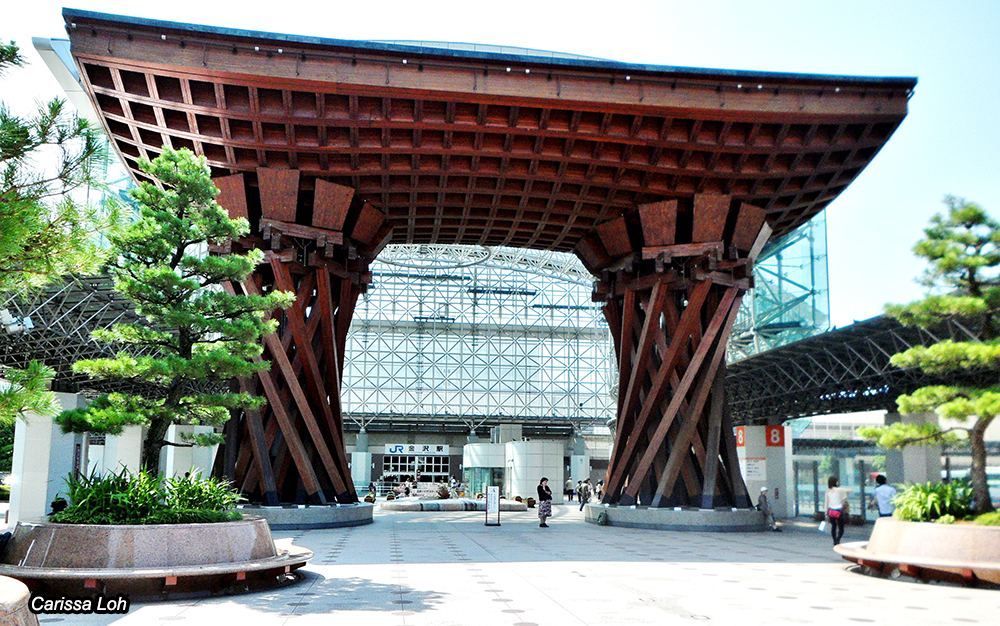
Kanazawa Station’s Tsuzumi Gate. (Image credit: JR East / Carissa Loh)
In Ishikawa Prefecture (石川県), there exists a historical railway station that is now revered as an architectural marvel. Kanazawa Station is a major railway station operated by JR West, Hokuriku Railroad (北陸鉄道 Hokuriku Tetsudō) and IR Ishikawa Railway (IRいしかわ鉄道 IR Ishikawa Tetsudō), and the station first opened in 1898.
The newly built station building has two prominent features, one of which is the eastern gate where a giant wooden gate awaits. The wooden gate was shaped after a tsuzumi (鼓), a Japanese traditional hand drum, and because of it, the eastern gate is also known as the Tsuzumi Gate (鼓門 Tsuzumi-mon).
The other prominent feature is the Motenashi Dome, a symbol of hospitality for visitors getting off at the station. Kanazawa is known for heavy rain and snow, and the dome is an expression of the locals to welcome them with a bright, rainproof open space made with over 3,000 glass panels. Both the Tsuzumi Gate and Motenashi Dome were built in 2005 in anticipation of the extension of the Hokuriku Shinkansen (北陸新幹線) to the station. The station also celebrated its 110th anniversary in 2008.
Karuizawa Station (軽井沢駅)

Karuizawa Station. (Image credit: JR EAST / Nakazawa)
Karuizawa Station is one of the oldest railway stations in Japan, and in the past, passengers travelled from here to Yokokawa (横川) via the Usui Pass, completing the train line linking Takasaki (高崎) and Naoetsu (直江津) to become the Shin’etsu Main Line (信越本線 Shin’etsu-honsen). However, with the opening of Nagano Shinkansen (長野新幹線, now Hokuriku Shinkansen (北陸新幹線)) in 1997, the Usui Pass was permanently closed and so was the section between Karuizawa and Yokokawa. The former emperor and empress of Japan also visited Karuizawa every summer when the station building was used, until the arrival of the shinkansen to the town.
(Note: if you like to know more about this section, you can look at my previous articles here and here!)
Closing
Rail travel in Japan is an unforgettable journey for all travellers, and they are bound to find historical railway station in the far reaches of the countries. Make a trip to Japan and seek out the most retro railway stations in Japan, and be transported back in time when witnessing railway station buildings that remain standing to this day!
(INSIDER TIP: If you’re planning to seek out some of the abovementioned retro railway stations in eastern Japan, it will definitely help your quest if you have the JR EAST PASS!)
JR EAST PASS (Tohoku area)

The JR EAST PASS (Tohoku area) and where you can use it. (Image credit: JR East)
The JR EAST PASS (Tohoku area) is an affordable pass that offers unlimited train rides on JR East lines, including bullet trains, within the valid area for 5 consecutive days. It's only ¥30,000, making it a considerable option for visitors to the region. Pass holders can also reserve seats online for up to a month in advance for free on the JR-EAST Train Reservation.
JR EAST PASS (Nagano, Niigata area)
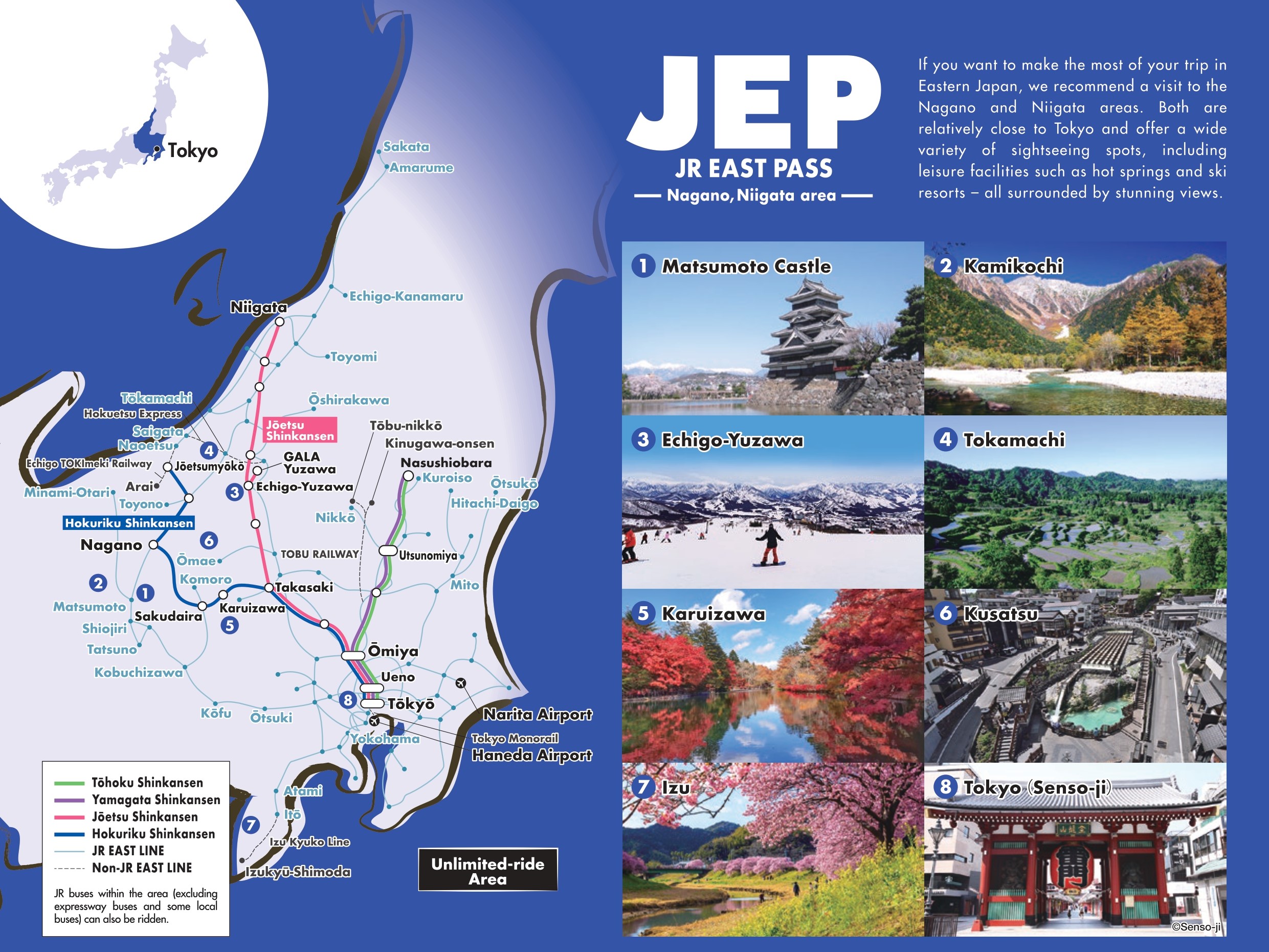
The JR EAST PASS (Nagano, Niigata area) and where you can use it. (Image credit: JR East)
The JR EAST PASS (Nagano, Niigata area) is an affordable pass that offers unlimited train rides on JR East lines, including bullet trains, within the valid area for 5 consecutive days. It's only ¥27,000, making it a considerable option for visitors to Nagano and Niigata. Pass holders can also reserve seats online for up to a month in advance for free on the JR-EAST Train Reservation.

The JR-EAST Train Reservation. (Image credit: JR East)
Header image credit: JR East




